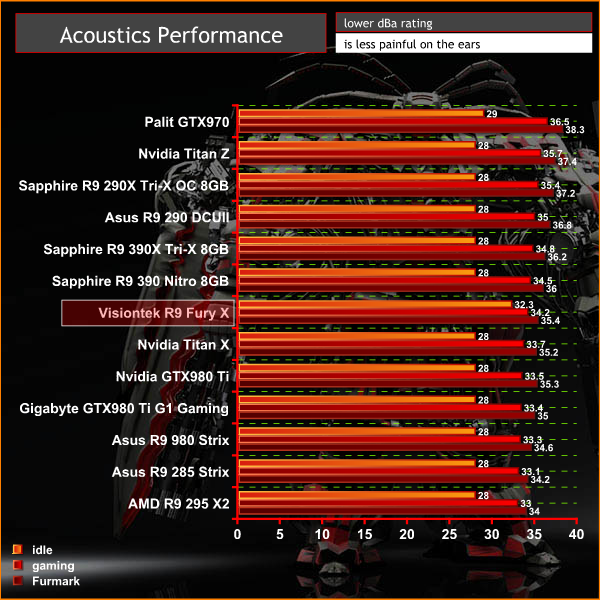We have built a system inside a Lian Li chassis with no case fans and have used a fanless cooler on our CPU. The motherboard is also passively cooled. This gives us a build with almost completely passive cooling and it means we can measure noise of just the graphics card inside the system when we run looped 3dMark tests.
We measure from a distance of around 1 meter from the closed chassis and 4 foot from the ground to mirror a real world situation. Ambient noise in the room measures close to the limits of our sound meter at 28dBa. Why do this? Well this means we can eliminate secondary noise pollution in the test room and concentrate on only the video card. It also brings us slightly closer to industry standards, such as DIN 45635.
KitGuru noise guide
10dBA – Normal Breathing/Rustling Leaves
20-25dBA – Whisper
30dBA – High Quality Computer fan
40dBA – A Bubbling Brook, or a Refrigerator
50dBA – Normal Conversation
60dBA – Laughter
70dBA – Vacuum Cleaner or Hairdryer
80dBA – City Traffic or a Garbage Disposal
90dBA – Motorcycle or Lawnmower
100dBA – MP3 player at maximum output
110dBA – Orchestra
120dBA – Front row rock concert/Jet Engine
130dBA – Threshold of Pain
140dBA – Military Jet takeoff/Gunshot (close range)
160dBA – Instant Perforation of eardrum

The Fury X is reasonably quiet when idle, but there is pump noise evident at all times.
Additionally our sample did exhibit coil whine when gaming – and it seems linked to the frame rate. As an additional test I confirmed this was still apparent with both Superflower and Seasonic power supplies in the system.
Unfortunately this actually negatively impacted the dBa readings above for the Fury X – as between idle and load, the fan on the radiator was very quiet. Most of the noise generated was actually from the pump, and associated coil whine. I got used to the pump noise after a few hours, but the coil whine was quite irritating.
This does not appear to be isolated to our particular sample as readers have sent us video links such as this, this, this and this regarding Fury X noise issues.
It could be argued, however, that one of the benefits of using a radiator and fan that are physically separate from the graphics card (and connected via tubing) is noise control. What is meant by ‘control‘ is that the user has a degree of freedom as to where the radiator and fan are positioned. This may help a system builder control their noise levels if, for example, they have the graphics card mounted in the case that is close to them and then mount the radiator and fan in a separate position or chamber of the case (think of a chassis such as the CaseLabs Magnum M10, for example). The noise-emitting fan can be moved further away from a user's ears.
 KitGuru KitGuru.net – Tech News | Hardware News | Hardware Reviews | IOS | Mobile | Gaming | Graphics Cards
KitGuru KitGuru.net – Tech News | Hardware News | Hardware Reviews | IOS | Mobile | Gaming | Graphics Cards


